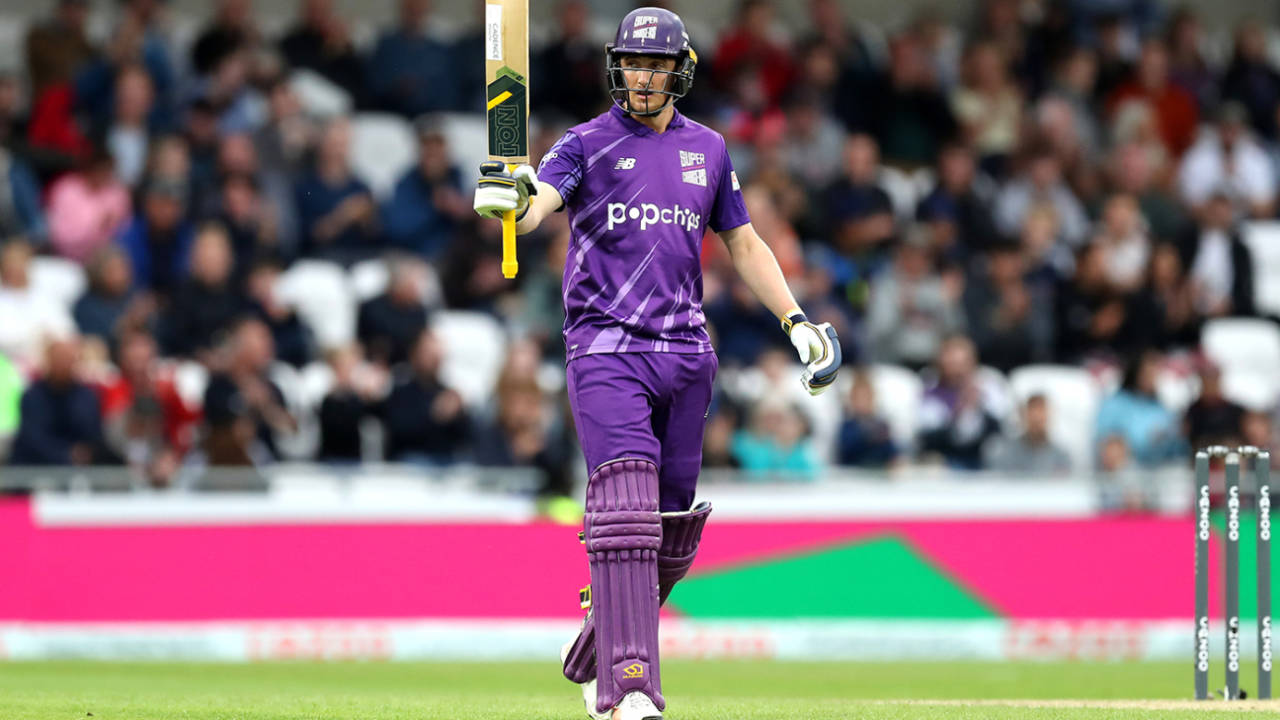Cautious draft picks expose confusion at heart of men's Hundred
Warner, Babar, Pooran among overlooked contingent as lack of availability dents tournament's quality
Matt Roller
05-Apr-2022
Tom Kohler-Cadmore is one of the big winners of this year's draft, but he has yet to play international cricket • Getty Images
'Buy British' was the mantra for teams in Monday's men's Hundred draft. When governments use that slogan, it is a tacit admission that foreign goods have offered consumers better value for money than their domestic alternatives. For the Hundred teams, however, it was a scarcity of overseas options that drove them to make picks as they did.
The Hundred's organisers have consistently promised "brilliant overseas players" and "world-class cricket" but this year, the competition's month-long window from August 3 to September 3 clashes with several men's bilateral series, the Asia Cup and the start of the Caribbean Premier League.
In the draft, five of the eleven vacant slots in the top £125,000 salary band were filled by domestic players: Joe Clarke and Tom Banton (Welsh Fire), Tom Kohler-Cadmore (Trent Rockets), Laurie Evans (Manchester Originals) and Liam Dawson (London Spirit). Uncertainty over the availability of leading overseas players was always expected to see domestic players do well, but even Dawson himself admitted he was "surprised" to have been picked at the band he was.
Each pick made sense at a micro level, with teams looking to fill gaps in their squads by recruiting the cream of the English crop, but the bigger picture is that the ECB will pay £625,000 in wages to a group of players who, for all their respective talents, have 34 England caps between them. That figure represents just under a third of the total wage bill across all eight teams in the women's competition, despite women's salaries doubling over the winter.
Babar Azam, Lockie Ferguson, Nicholas Pooran and David Warner were among those unsold due to uncertainty over their availability.
"Availability is a big issue for the overseas guys throughout the whole tournament," admitted Eoin Morgan, London Spirit's captain and a prominent advocate for the Hundred, speaking to ESPNcricinfo in a forthcoming interview. "I think you can go through every team and who they selected and there are actually very few overseas that are available throughout the whole tournament."
As a result, several men's sides have opted to use at least one of their overseas picks on cheaper options, with seven of the twenty-four foreign players signed for £60k or less (each men's team will add a fourth 'wildcard' overseas player to their squad in June or July for £50,000, with a maximum of three permitted in the same XI). While their selections make sense for an Oval Invincibles side looking to add power to its middle order, Rilee Rossouw and Hilton Cartwright were not the overseas draw-cards that the ECB had envisaged when they came up with the Hundred.
Perhaps the problem is the conflict between the tournament's overall aims and the disparate, individual ambitions of those involved in selecting the squads. The ECB would love teams to sign players based on their reputation - it seems like a missed opportunity that Chris Gayle has twice registered for a draft without being picked - in order to shift tickets and merchandise, but an analyst hoping to impress a coach in order to keep their job would rather prove their worth by signing a hidden gem.
The decision to stage the draft behind closed doors for a second year in a row added to the sense that nobody is quite sure what this tournament is, or who it is for. Back in 2019, the draft was hailed by the ECB as "an historic occasion in British sport, as the first major UK sport competition draft to be held in this country," shown live in a prime Sunday night slot on three Sky channels and online. Two-and-a-half years later, it took place remotely on a Monday morning before being drip-fed out through press releases and live blogs on a Tuesday afternoon, after most of the main cricketing stories had already been broken.
Showing the draft live would have presented expensive logistical challenges, not least with most head coaches based overseas and working in Mumbai during the IPL, but they would not be insurmountable. Even if the Hundred is pitched at new fans, existing ones are always intrigued by team construction: the most recent PSL draft had over a million views on YouTube, and viewing figures for the IPL auction regularly dwarf those for actual games.
By contrast, the women's competition continues to attract the best players in the world. Meg Lanning leads a contingent of eleven Australians who will stay in the UK after the Commonwealth Games and despite the salary discrepancies - Lanning will earn just £1,250 more than the lowest-paid men's players - the prevailing sense is that the women's Hundred is working better than the men's.
The ECB claimed with some justification that the tournament's first season was a success, emboldened by strong viewing figures and ticket sales in its first season, but the question that its many critics continue to ask is: at what cost? As Andrew Strauss' high performance review into the structure of the English game looms, the Hundred still resembles a speculative venture.
Matt Roller is an assistant editor at ESPNcricinfo. @mroller98

